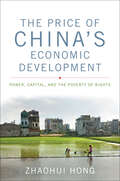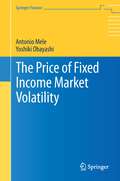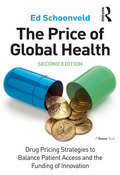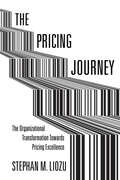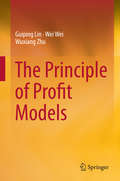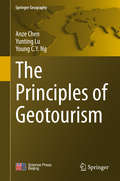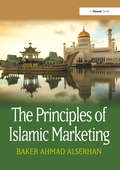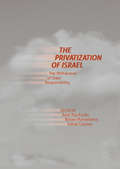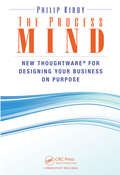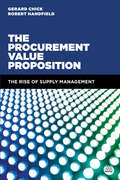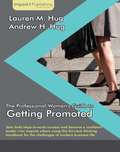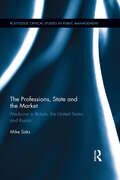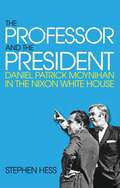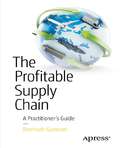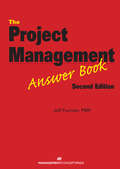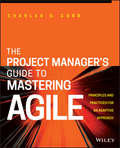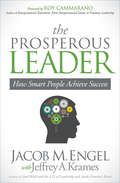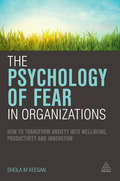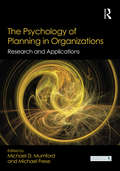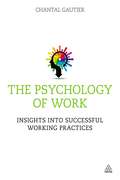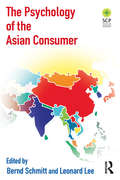- Table View
- List View
The Price of China's Economic Development: Power, Capital, and the Poverty of Rights (Asia In The New Millennium Ser.)
by Zhaohui Hong“This work provides a theoretically sophisticated analysis of major political, social, economic, and cultural trends in China.” —Roger des Forges, author of Chinese Walls in Time and SpaceThe People’s Republic of China has experienced significant transformations since Deng Xiaoping instituted economic reforms in 1978. Subsequent leaders continued and often broadened Deng’s policies, shifting the nation from agrarianism to industrialism, from isolation to internationalism, and from centralized planning to market-based economics. As the world strives to understand the nation’s rapid development, few observers have comprehensively examined the social and cultural price of the economic boom for the majority of the Chinese people.Zhaohui Hong assesses the sociocultural consequences of these reforms in this provocative study. He contends that modern China functions as an oligarchy or plutocracy ruled by an alliance of political power and private capital where the boundaries between the private and public sectors are constantly shifting. This “power-capital institution” based on three millennia of Confucian ideology and decades of Maoist communism exercises monopolistic control of public resources at the expense of civil society and social justice for the majority of citizens.The Price of China’s Economic Development urges policymakers to alter their analytic lens. While industrial and commercial development is quantitatively measured, Hong argues that social progress should be assessed qualitatively, with justice its ultimate goal and fair allocation of resources and opportunity as the main index of success. This sophisticated analysis introduces English speakers to the varied and significant work of contemporary Chinese scholars and substantially enriches the international dialogue.“Presents a new perspective on China’s economic growth and ongoing political problems.” —Xiaobing Li, author of China’s War in Korea
The Price of Fixed Income Market Volatility
by Antonio Mele Yoshiki ObayashiFixed income volatility and equityvolatility evolve heterogeneously over time, co-moving disproportionatelyduring periods of global imbalances and each reacting to events of differentnature. While the methodology for options-based "model-free" pricingof equity volatility has been known for some time, little is known aboutanalogous methodologies for pricing various fixed income volatilities. This book fills this gap and provides aunified evaluation framework of fixed income volatility while dealing withdisparate markets such as interest-rate swaps, government bonds, time-depositsand credit. It develops model-free, forward looking indexes of fixed-incomevolatility that match different quoting conventions across various markets, anduncovers subtle yet important pitfalls arising from naïve superimpositions ofthe standard equity volatility methodology when pricing various fixed incomevolatilities.
The Price of Global Health: Drug Pricing Strategies to Balance Patient Access and the Funding of Innovation
by Ed SchoonveldPublic debate on the rising cost of new biotechnology drug treatments has intensified over the last few years as healthcare budget pressures have mounted under a strained economy. Meanwhile, the demand for new, effective medical and drug treatments continues to rise as unhealthy lifestyles cause further increases in diabetes and cardiovascular disease. Global drug pricing is one of the most hotly debated yet least understood aspects of the pharmaceutical industry. How should drug prices be set and what does it mean for patients? Why do governments increasingly get involved, and what is its impact on the global competitive environment? How can a life-saving industry have a poorer image than gun and tobacco industries, whose products are associated with death? Ed Schoonveld explains how pharmaceutical prices are determined in a complex global payer environment and what factors influence the process. His insights will help a wide range of audiences, from healthcare industry professionals to policy makers and the broader public, to gain a better understanding of this highly complex and emotionally charged field. The Price of Global Health is recognized as a valued and unique reference book that covers a complete array of topics related to global pharmaceutical pricing. It contains an in-depth but straightforward exploration of the pharmaceutical pricing strategy process, its underlying market access, general business and ethical considerations, and its implications for payers, physicians and patients. It is a much-needed and invaluable resource for anybody interested or involved in, or affected by, the development, funding and use of prescription drugs. In particular, it is of critical importance to pharmaceutical company executives and other leaders and professionals in commercialization and drug development, including marketing, business development, market access and pricing, clinical development, drug discovery, regulatory affairs, health outcomes, market research and public affairs. The second edition includes new chapters on payer value story development, oncology, orphan drugs and payer negotiations. Furthermore, many country chapters have been substantially updated to reflect changes in the healthcare systems, including the Affordable Care Act in the US, AMNOG in Germany, medico-economic requirements in France and many other country-specific changes. Lastly, almost every chapter has been updated with new examples and illustrations.
The Pricing Journey: The Organizational Transformation Toward Pricing Excellence
by Stephan M. LiozuInnovations in pricing can be transformative, but to reach their potential companies must devote equal attention to technical and organizational capabilities. Most firms, however, only pay attention to the technical dimensions of pricing, which severely limits the success of their initiatives. To remedy this, The Pricing Journey provides an integrated guide to the organizational, social, and behavioral aspects of pricing—drawing on principles of socio-technical change. Based on extensive qualitative and quantitative research in an array of firms around the world, Stephan M. Liozu provides a practical roadmap for management teams that aim to reach a new level of pricing power. Liozu introduces the 5 C model of transformation, which relies on change, capabilities, champions, confidence, and center-led organizational design to create effective and lasting pricing strategies. Rooting his recommendations in research and practice, Liozu proposes specific capabilities to develop on the road to pricing excellence. This book prepares pricing and marketing professionals to be true strategic partners, while contributing the study of pricing transformation.
The Principle of Profit Models
by Wuxiang Zhu Wei Wei Guiping LinThis book mainly focuses on defining profit models, on how many main kinds of profit models there are, how profit models can change a company, and how to tailor a profit model to the needs of a certain company. In this context, profit models are classified as fixed-income, remaining-profit and profit-sharing, admission, toll, parking, fuel and sharing fees, profit sources, customer pricing, auction, combined pricing, etc. The logic behind all these profit models will be analyzed in detail and numerous micro-cases will be introduced. All of the micro-cases discussed are the best profit model practices used by outstanding enterprises, mainly from China and the USA (including HomeAway, Priceline, Tencent, Sina, Google, the Voice of China, CSPN and so on). These models will be complemented by a wealth of figures and additional tools to help readers better understand the principle of profit models. As such, the book not only explains "why" entrepreneurs preferred to apply a specific kind of profit model and not others, but also answers "how" they derived that model.
The Principles of Geotourism
by Anze Chen Yunting Lu Young C. Y. NgThe book introduces tourism earth-science as a new scientific discipline by applying the principles of earth-science in the study of natural and human tourism resources. It involves studying the geo-scientific characteristics of these tourism resources through surveys, evaluation and aesthetic value assessment. It also discusses about the principles behind geopark establishment and management. It is an important publication providing direction for geopark and tourism developments in China. The book is a tool for geological heritage survey, assessment and research. It can also be used to assist planning of geopark, national parks, heritage protection and scientific interpretation. It is a valuable teaching material for teachers and students of geoscience and tourism as well as providing useful guidance for geopark managers and tour guides in their operation. In addition, the book also offers scientific knowledge of the surrounding natural and cultural landscapes to the public and the general visitors.
The Principles of Islamic Marketing
by Baker Ahmad AlserhanThe Principles of Islamic Marketing fills a gap in international business literature covering the aspects and values of Islamic business thought. It provides a framework and practical perspectives for understanding and implementing the Islamic marketing code of conduct. It is not a religious book. The Islamic Economic System is a business model adopted by nearly one quarter of the world’s population. Baker Alserhan identifies the features of the Islamic structure of International Marketing practices and ethics. Adherence to such ethical practices elevates the standards of behaviour of traders and consumers alike and creates a value-loaded framework for meaningful cooperation between international marketers and their Muslim markets. His book provides a complete guide for an organization when managing its entire marketing function or when customising part of its offering to suit Muslim customers. It addresses the challenges facing marketers involved in business activities with and within Islamic communities, the knowledge needs of academic institutions, and the interest of multinationals keen on tapping the huge Islamic markets. Along the way, Baker Alserhan provides insights into key elements such as, distribution channels, retailing practices, branding, positioning, and pricing; all within the Muslim legal and cultural norms. This second edition brings the book up to date and features a number of new case studies and two additional chapters on Maqasid Al Shariah and the Islamic economy, and a strategic perspective on Islamic marketing and branding.
The Pristine Culture of Capitalism
by Ellen Meiksins WoodA historical essay on old regimes and modern states In this lively and wide-ranging book, Ellen Meiksins Wood argues that what is supposed to have epitomized bourgeois modernity, especially the emergence of a "modern" state and political culture in Continental Europe, signaled the persistence of pre-capitalist social property relations. Conversely, the absence of a "modern" state and political discourse in England testified to the presence of a well-developed capitalism. The fundamental flaws in the British economy are not just the symptoms of arrested development but the contradictions of the capitalist system itself. Britain today, Wood maintains, is the most thoroughly capitalist culture in Europe.
The Privatization of Israel: The Withdrawal of State Responsibility
by Amir Paz-Fuchs Ronen Mandelkern Itzhak GalnoorThe book is the first to cover all areas of privatization in Israel and one of the first to do so in general, including state infrastructure, immigration policy, land, health, education, welfare, regulation, and policy design. As such, it offers a comprehensive volume for students, policy makers, and scholars interested in the economic, sociological, political, and legal perspectives of a major policy trend that has changed the face and character of the modern state. In addition, it is a vital contribution to those who have an interest in changes in Israeli society, politics, and economy.
The Process Mind: New Thoughtware - for Designing Your Business on Purpose
by Philip KirbyWhat if you could double your productivity without additional capital investment? What if you could outperform your competition by changing the way you think? What if you could be fast, flexible, and low cost?In The Process Mind, Philip Kirby not only opens your mind to these possibilities but shows you how it is done. The book emphatically makes t
The Procurement Value Proposition
by Gerard Chick Robert HandfieldThe aim of The Procurement Value Proposition is to contemplate the value proposition to the business of contemporary Procurement and Supply Management. Business organisations are going through rapid external and internal organisational changes due to an increased focus on sustainability and corporate responsibility, technological advances, geo-political and macro-economic change and demographic shifts. Value and what it means is the key purchasing and supply chain management challenge the authors seek to address in this book. If purchasing and supply chain managers are to embrace this challenge they have to change the ways they operate. This requires new ways of thinking about supply structures and processes and new skills and competencies. Consideration has been given to geographical contexts and differences highlighted between the US, the UK and China. With input, observations and case studies from CPOs, Commercial Directors and other Procurement and business leaders, this is an invaluable book which fills a gap beyond MCIPS, the generally accepted entry level of professional procurement. It will appeal to new high fliers in procurement organisations, both practitioners and consultants who wish to develop future practice and students studying MScs on Procurement.
The Procurement Value Proposition: The Rise of Supply Management
by Gerard Chick Robert HandfieldWINNER: ACA-Bruel 2015 - Grand PrixBusinesses are going through rapid change due to an increased focus on sustainability and corporate responsibility, technological advances, geo-political and macro-economic change, and demographic shifts. If purchasing and supply chain managers are to embrace these challenges they must develop new ways of thinking about supply structures and processes as well as new skills and competencies. The Procurement Value Proposition examines these important changes that will have a profound effect on the way future procurement is carried out. It considers the implications of global economic transformation for procurement set against: changes in business contexts, purchasing strategies, organisational structure, roles and responsibilities, system development and skills required to work in the profession. This book discusses the value proposition offered by contemporary procurement to the sustainability and development of business. They examine how organizations that position procurement as a core business function will be able to drive a more competitive lever for change, and more readily adapt to the forces driving rapid change in the current global environment. The Procurement Value Proposition features case studies of companies that are moving through procurement transformation in a continual phase of movement and adaption to the multitude of shifts that are occurring. It features input, observations and case studies from CPO's, Commercial Directors and other Procurement and business leaders. The book considers a variety of geographical contexts and highlights differences between the US, the UK and China. Awarded the Grand Prix ACA-Bruel for its important contributions to the research and practice in procurement and supply chain management, it has been recognized for its ambitious vision of procurement.
The Professional Woman's Guide to Getting Promoted
by Lauren M. Hug Andrew H. HugWith insights drawn from experience by Lauren M. Hug, a professional woman, and straight-talk from Andrew H. Hug, a professional man, this one-of-a-kind book shows you how to develop key skills and craft strategic relationships that elevate your value in the business world. Featuring worksheets, charts, exercises, and sample conversations, this unique book will help you create your personal career strategy and take customized steps towards advancement and success. You'll learn how to communicate and demonstrate your workplace worth effectively, making your promotion not only likely—but vital to your organization.
The Professions, State and the Market: Medicine in Britain, the United States and Russia (Routledge Critical Studies in Public Management)
by Mike SaksThis unique book enhances our understanding of the links between professions, the state and the market – and their implications for the public in terms of professional practice. In so doing, the book adopts a neo-Weberian perspective, in which professions are seen as a form of exclusionary social closure based on legal boundaries established by the state. To illustrate the overarching theme, the book considers how healthcare in general, and medicine in particular as a form of professional work, is organized in public and private arenas in three societies with different socio-political philosophies - namely, Britain, the United States and Russia. As such, it examines the varying extent to which the development of independent professional organizations has been enhanced or restricted in public, as compared to more privatized social contexts. The comparative perspective adopted in this book thereby provides insight into the organization of professional work in different contexts and the all-important effects of this on delivery to the public. This book will be of particular interest to scholars, researchers and students of Management, Public Policy and Health Care.
The Professor and the President
by Stephen HessWhat happens when a conservative president makes a liberal professor from the Ivy League his top urban affairs adviser? The president is Richard Nixon, the professor is Harvard's Daniel Patrick Moynihan. Of all the odd couples in American public life, they are probably the oddest. Add another Ivy League professor to the White House staff when Nixon appoints Columbia's Arthur Burns, a conservative economist, as domestic policy adviser. The year is 1969, and what follows behind closed doors is a passionate debate of conflicting ideologies and personalities.Who won? How? Why? Now nearly a half-century later, Stephen Hess, who was Nixon's biographer and Moynihan's deputy, recounts this fascinat-ing story as if from his office in the West Wing.Daniel Patrick Moynihan (1927-2003) described in the Almanac of American Politics as "the nation's best thinker among politicians since Lincoln and its best politician among thinkers since Jefferson", served in the administrations of four presidents, was ambassador to India, and U.S. representative to the United Nations, and was four times elected to the U.S. Senate from New York.Praise for the works of Stephen Hess Organzing the PresidencyAny president would benefit from reading Mr. Hess's analysis and any reader will enjoy the elegance with which it is written and the author's wide knowledge and good sense. -The Economist The Presidential Campaign Hess brings not only first-rate credentials, but a cool, dispassionate perspective, an incisive analytical approach, and a willingness to stick his neck out in making judgments. - American Political Science ReviewFrom the Newswork Series It is not much in vogue to speak of things like the public trust, but thankfully Stephen Hess is old fashioned. He reminds us in this valuable and provocative book that journalism is a public trust, providing the basic information on which citizens in a democracy vote, or tune out. -- Ken Auletta, The New Yorker
The Profitable Supply Chain
by Ramnath GanesanThe Profitable Supply Chain: A Practitioner's Guide provides a first-principles approach to understanding the drivers of today's successful supply chains, covering everything from inventory and demand management to network planning to technology-driven improvements in efficient supply chain management. Apart from introducing the latest concepts and methods, supply chain expert and consultant Ramnath Ganesan provides numerous real-world examples and cases to clarify how his process-oriented approach can be applied to specific situations, together with spreadsheet functions when appropriate. Practitioners will be especially interested, for example, in the sections on assessing external factors for demand, modifying network routings in response to rising fuel prices, designing a framework for identifying issues and tracking actions, and instituting financial measures to track performance. The book addresses situations found in such industries as consumer electronics, healthcare, telecommunications, consumer goods, industrial equipment, building materials, and many others. No matter the industry, all firms trading products face operational challenges in producing and/or moving goods in a geographically dispersed global network while fulfilling customer demand in a timely and cost-efficient manner. Such demands can only be supported by a rigorous approach that aligns supply with demand, an approach this book outlines clearly and simply. The Profitable Supply Chain will prove a valuable reference for production schedulers, plant managers, material managers, demand planners, and supply chain executives. Among other things, it covers the following topics in great depth: How to design and implement an efficient, scalable supply chain management process from the ground up--or improve the one you have. How to maintain adequate inventory levels while reducing the cost of supplying products. How to implement specific metrics that help improve supply chain performance and forecast accuracy. How to gain competitive advantages through the latest advances in IT architecture and software. This book will also be of immense value to information technology professionals. That includes enterprise application developers charged with designing and implementing a supply chain IT architecture, as well as those administering and maintaining an enterprise resource planning or advance planning system. There are few areas in business more ripe for cost reductions than in the supply chain. The Profitable Supply Chain is therefore your go-to resource for making supply chain operations leaner, more efficient, and ultimately far more profitable than they are now.
The Project Management Answer Book
by Jeff Furman PMPIf it's essential to project management... it's in here!The first edition of The Project Management Answer Book addressed all the key principles of project management that every project manager needs to know. With a new chapter on scrum agile, updates throughout, and many new PMP® test tips, this new edition builds on that solid foundation.The structure of this update maps closely to the PMBOK® Guide, Fifth Edition, and is designed to assist anyone studying for the PMP® and other certification exams. Helpful sections cover: • Networking and social media tips for PMs, including the best professional organizations, virtual groups, and podcast resources• The formulas PMs need to know, plus a template to help certification candidates prepare and self-test for their exams• Quick study sheet for the processes covered on the PMP® exam• Key changes in PMBOK® Guide, Fifth Edition, for readers familiar with earlier versions who want "the skinny" on the new version.PMs at every level will find real gold in the information nuggets provided in this new edition. Those new to project management will find the comprehensive coverage and the depth of the answers especially valuable, and will like the easy-to-read style and Q&A format. For experienced managers looking for new tools and skills to help them pass their PMP® or other certification exams, this is a must-have resource.
The Project Manager's Guide to Mastering Agile: Principles and Practices for an Adaptive Approach
by Charles G. CobbStreamline project workflow with expert agile implementation The Project Management Profession is beginning to go through rapid and profound transformation due to the widespread adoption of agile methodologies. Those changes are likely to dramatically change the role of project managers in many environments as we have known them and raise the bar for the entire project management profession; however, we are in the early stages of that transformation and there is a lot of confusion about the impact it has on project managers: There are many stereotypes and misconceptions that exist about both Agile and traditional plan-driven project management, Agile and traditional project management principles and practices are treated as separate and independent domains of knowledge with little or no integration between the two and sometimes seen as in conflict with each other Agile and "Waterfall" are thought of as two binary, mutually-exclusive choices and companies sometimes try to force-fit their business and projects to one of those extremes when the right solution is to fit the approach to the project It’s no wonder that many Project Managers might be confused by all of this! This book will help project managers unravel a lot of the confusion that exists; develop a totally new perspective to see Agile and traditional plan-driven project management principles and practices in a new light as complementary to each other rather than competitive; and learn to develop an adaptive approach to blend those principles and practices together in the right proportions to fit any situation. There are many books on Agile and many books on traditional project management but what’s very unique about this book is that it takes an objective approach to help you understand the strengths and weaknesses of both of those areas to see how they can work synergistically to improve project outcomes in any project. The book includes discussion topics, real world case studies, and sample enterprise-level agile frameworks that facilitate hands-on learning as well as an in-depth discussion of the principles behind both Agile and traditional plan-driven project management practices to provide a more thorough level of understanding.
The Prosperous Leader: How Smart People Achieve Success
by Jeffrey A. Krames Jacob M. EngelAn actionable, easy-to-understand guide that gives you the tools you need to succeed and achieve prosperity. The Prosperous Leader articulates twenty-four steps for those starting or leading a business or organization or looking to move up to the next level. Outlining the many different theories that abound today, Engel combines them with real life stories of how ordinary yet committed people applied each of these principles to achieve success. With the six C&’s of organizational growth and development that demonstrate a clear correlation between the style of the entrepreneur and whether or not prosperity can be realistically achieved, you will be able to chart your own path as you learn the skills you need to improve your own leadership and management capabilities. In doing so, you will examine your own unique individual strengths and weaknesses so that you can maximize the former while mitigating the latter—giving you the power to take control of your own success.
The Psychology of Fear in Organizations
by Sheila KeeganIn the context of global economic recession, fear has become institutionalized in many organizations, both in the private and public sectors. Board directors are under pressure from shareholders, senior executives are attempting to maintain sales in a nervous market and many people are concerned about job security and maintaining their living standards. This book shows how fear manifests itself in large organizations, how it impacts on the workforce and how by reducing our willingness to take risks and to innovate, it can inhibit economic growth and innovation, at both an individual and corporate level. The Psychology of Fear in Organizations examines the psychological barriers to innovation and presents initiatives to loosen the paralysis caused by the economic downturn.
The Psychology of Fear in Organizations: How to Transform Anxiety into Well-being, Productivity and Innovation
by Sheila KeeganIn the context of global economic recession, fear has become institutionalized in many organizations, both in the private and public sectors. Board directors are under pressure from shareholders, senior executives are attempting to maintain sales in a nervous market and many people are concerned about job security and maintaining their living standards. The Psychology of Fear in Organizations shows how fear manifests itself in large organizations, how it impacts on the workforce and how by reducing our willingness to take risks and to innovate, it can inhibit economic growth and innovation, at both an individual and corporate level. The Psychology of Fear in Organizations examines the psychological barriers to innovation and presents initiatives to loosen the paralysis caused by the economic downturn. It presents psychological theory in an accessible way to provide a better understanding of the needs and fears of people and how they can be supported to improve productivity and innovation. Online supporting resources include lecture slides on how to harness fear to fuel innovation.
The Psychology of Innovation in Organizations
by David H. Cropley Arthur J. Cropley Cropley, David H. and Cropley, Arthur J.In today's highly competitive market, organizations increasingly need to innovate in order to survive. Drawing on a wealth of psychological research in the field of creativity, David H. Cropley and Arthur J. Cropley illustrate practical methods for conceptualizing and managing organizational innovation. They present a dynamic model of the interactions between four key components of creativity - product, person, process, and press - which function as building blocks of innovation. This volume sheds new light on the nature of innovative products and the processes that generate them, the psychological characteristics of innovative people, and the environments that facilitate innovation. It also fills a significant gap in the current literature by addressing the paradoxical quality of organizational innovation, which may be both helped and hindered by the same factors. The authors demonstrate that with proper measurement and management, organizations can effectively encourage individuals to produce and take advantage of novel ideas.
The Psychology of Planning in Organizations: Research and Applications (Organization and Management Series)
by Michael D. Mumford Michael FreseThis book examines planning as the critical influence on performance at work and in organizations. Bridging theory and practice, it unites cutting-edge research findings from cognitive science, social psychology, industrial and organizational psychology, strategic management, and entrepreneurship, and describes the practical applications of these research findings for practitioners interested in improving planning performance in organizations.
The Psychology of Work
by Chantal GautierThe Psychology of Work integrates psychological theory with personal narrative from global industry leaders, as well as those entering the workforce, to offer tangible insights into the real world of work. It is ideal for students, professionals and anyone with an interest in how successful organizations operate. It charts the development of the field of organizational psychology and provides the key theoretical frameworks. Crucially, it explores how these can be utilised to enhance organizational culture, and why this is so relevant and important in the modern workplace.Through the inclusion of interviews with students, The Psychology of Work reveals what the future workforce expect of the organizations that they are going in to and encourages students reading the book to reflect on what kind of leaders they would like to be. The book is also a valuable resource to support professionals and practitioners, highlighting current working practices and the need for change, offering practical guidance on how to bring the 'humane' back into organizational life.
The Psychology of the Asian Consumer
by Bernd Schmitt Leonard LeeWhy is it important to conduct research on the psychology of the Asian consumer? What research themes have already emerged? What are the relevant theories and practical applications based on this research? These are some of the questions and issues addressed in this unique book. With chapters written by experts in their field, The Psychology of the Asian Consumer highlights how consumer psychology can contribute to an understanding of Asian consumer behaviour and is especially timely in light of today's global economy and its focus on the Pacific Rim. Chapters are organised around the key concepts of theory and culture and include numerous case studies and practical applications. The book focuses on research summaries that provide readers with important, need-to-know information.
